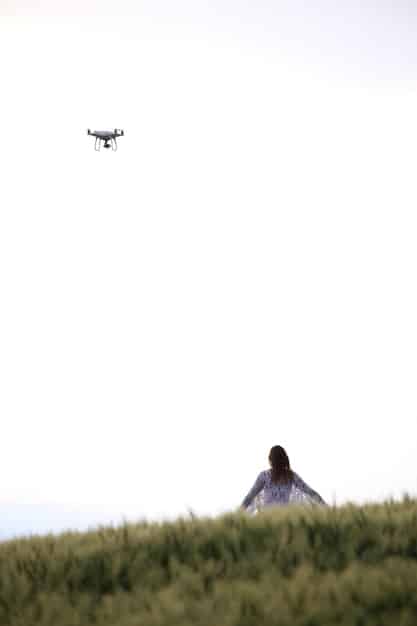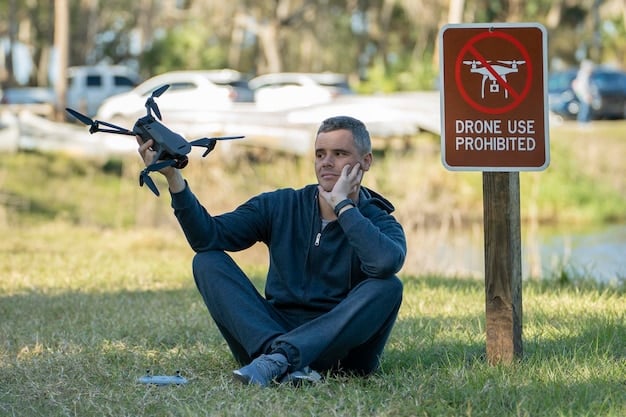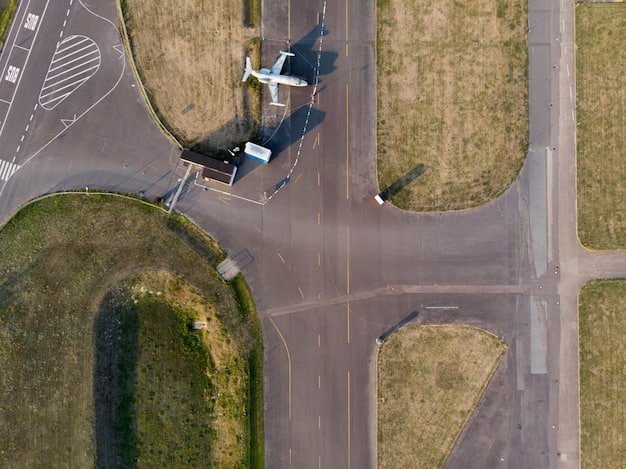New Drone Regulations: What You Need to Know Before You Fly in 2024

New drone regulations are constantly evolving, and staying informed is crucial for legal and safe flying; understand the key updates and requirements before you take to the skies in 2024.
Keeping up with the ever-changing landscape of new drone regulations can feel like a full-time job. Before you launch your drone, it’s essential to understand the rules in place to ensure you are flying legally and safely.
Understanding the Basics of Drone Regulations
Drone regulations are in place for a reason – to ensure the safety of the airspace and people on the ground. These rules are set by various aviation authorities and apply to all drone operators, regardless of experience level.
Before you even think about flying, understanding these basics is paramount. Let’s delve into what you need to know.
Registration Requirements
In the US, most drones need to be registered with the Federal Aviation Administration (FAA). This process involves providing your name, address, and drone information. Once registered, you’ll receive a registration number that must be displayed on your drone.
Operating Rules
The FAA also has specific operating rules that you need to follow. These rules cover aspects like altitude limits, maintaining visual line of sight, and avoiding restricted airspace. Failing to adhere to these rules can result in hefty fines and other penalties.
- Altitude Limit: Drones cannot be flown above 400 feet.
- Visual Line of Sight: You must always be able to see your drone without any aid (like binoculars).
- Restricted Airspace: Avoid flying near airports, military bases, and other restricted areas.
Understanding these fundamental aspects of drone regulations is your first step toward responsible drone operation.

Key Updates in Drone Laws for 2024
As technology advances, so do the regulations surrounding drone usage. In 2024, there are several key updates you need to be aware of. These updates often stem from the need to integrate drones safely into the national airspace system.
Staying informed about these changes helps you remain compliant and avoid unexpected issues.
Remote ID Mandate
One of the most significant updates is the Remote ID mandate. This requires drones to broadcast identification and location information during flight, enabling authorities to identify and track drones in real-time.
Night Operations
Recent changes have made it easier to fly drones at night, but certain requirements must be met. This includes equipping your drone with anti-collision lights and completing the required training.
- Anti-collision Lights: Must be visible for at least three statute miles.
- Training: Complete a FAA-approved training course on nighttime drone operations.
- Waivers: In some cases, waivers may be required for specific operations.
By keeping up with these updates, you can navigate the regulatory landscape effectively and enjoy the benefits of drone technology while remaining compliant.
Staying updated on these changes ensures safer skies for everyone.
The Importance of FAA Regulations
The Federal Aviation Administration (FAA) plays a crucial role in regulating drone operations in the United States. Their regulations are designed to ensure the safety and efficiency of the national airspace system, and compliance is essential for all drone operators.
Understanding the FAA’s role and regulations is key to flying responsibly.
What is the FAA’s role?
The FAA is responsible for setting and enforcing the rules for drone operations. This includes registration requirements, operating rules, and airspace restrictions. They also provide guidance and resources to help drone operators understand and comply with the regulations.
Why Follow FAA Guidelines?
Following FAA guidelines is not just about avoiding fines; it’s about safety. By adhering to the regulations, you are helping to prevent accidents and ensure that drones can be integrated safely into the airspace system.
Understanding and respecting these regulations highlights the importance of responsible drone operations.

Steps to Ensure Compliance Before You Fly
Ensuring compliance with drone regulations involves several steps that you should take before each flight. This preparation can help you avoid potential violations and ensure a safe and enjoyable flying experience.
Let’s walk through what you should do before every flight.
Pre-Flight Checklist
Before each flight, it’s crucial to conduct a thorough pre-flight checklist. This includes inspecting your drone for any damage, checking the weather conditions, and verifying that you are operating in a safe and legal location.
Understanding Airspace Restrictions
One of the most important steps is to understand any airspace restrictions in your area. Use tools like the FAA’s B4UFLY app to identify any restricted areas, such as airports or military bases, and ensure you are operating within the allowed airspace.
- Check Weather: Ensure weather conditions are suitable for flying.
- Inspect Drone: Look for any signs of damage.
- Verify Location: Use the B4UFLY app to check for airspace restrictions.
By following these steps, you can minimize the risk of non-compliance and enjoy a worry-free drone flying experience.
Flying safely and within the rules is the key to a great experience.
The Consequences of Non-Compliance
Failing to comply with drone regulations can have serious consequences. These can range from monetary fines to criminal charges, depending on the severity of the violation. It’s crucial to understand these potential repercussions.
Non-compliance can lead to severe penalties – both financial and legal.
Fines and Penalties
The FAA can impose significant fines for violations of drone regulations. These fines can range from a few hundred dollars to tens of thousands of dollars, depending on the nature and severity of the violation.
Legal Ramifications
In some cases, non-compliance can lead to criminal charges. This is more likely to occur if the violation results in an accident or injury. The legal ramifications can include imprisonment and a permanent criminal record.
It is essential to recognize that following drone regulations is not just a suggestion – it is a legal requirement. You are avoiding potential legal troubles.
Resources for Staying Updated on Drone Regulations
Staying updated on drone regulations can seem overwhelming, but there are numerous resources available to help you. From official government websites to community forums, these resources can provide valuable information and guidance.
To stay informed, explore these valuable resources.
FAA Website
The FAA website is an essential resource for all things drone-related. Here, you can find the latest regulations, guidance documents, and safety information. Regularly checking the FAA website will keep you informed about any changes or updates.
Online Forums and Communities
There are many online forums and communities dedicated to drone flying. These platforms can be a great place to ask questions, share experiences, and stay informed about the latest news and trends in the drone world.
- FAA Website: Official source for regulations and guidance.
- B4UFLY App: Check airspace restrictions.
- Drone Communities: Connect with other drone enthusiasts.
By leveraging these resources, you can stay ahead of regulatory changes and ensure that you are always flying safely and legally. Engaging with these resources can significantly contribute to your knowledge base.
| Key Aspect | Brief Description |
|---|---|
| 📝 Registration | Most drones must be registered with the FAA. |
| 🌐 Remote ID | Drones must broadcast identification and location info. |
| 🌃 Night Flying | Requires anti-collision lights and training. |
| 🗺️ Airspace | Use B4UFLY app to check for restrictions. |
Frequently Asked Questions
▼
Yes, if your drone weighs more than 0.55 pounds (250 grams), you need to register it with the FAA. The registration is valid for three years.
▼
Remote ID requires drones to broadcast identification and location information during the flight, allowing authorities to identify drone owners in real-time for safety and security.
▼
Yes, you can fly at night if your drone has anti-collision lights and you have completed the required FAA-approved training for nighttime operations.
▼
Report any accident to the FAA if it results in serious injury, loss of consciousness, or more than $500 in property damage to the drone or another object.
▼
You can find the latest updates on the FAA website or by subscribing to drone-related news and forums. Staying informed is crucial for compliant flying.
Conclusion
Staying compliant with new drone regulations is crucial for every drone pilot. By understanding the rules, keeping up with the updates, and using available resources, you can ensure a safe and legal flying experience. Always remember, responsible flying contributes to the growth and acceptance of drone technology.





